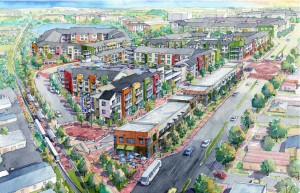The Pope weighed in on Thursday with strong moral arguments in favor of addressing climate change. But in his landmark encyclical, he apparently bashed cap-and-trade as a means of addressing carbon pollution:
“The strategy of buying and selling ‘carbon credits’ can lead to a new form of speculation which would not help reduce the emission of polluting gases worldwide,” Francis wrote in his wide-ranging encyclical on the environment and global warming.
“This system seems to provide a quick and easy solution under the guise of a certain commitment to the environment, but in no way does it allow for the radical change which present circumstances require,” he wrote. “Rather, it may simply become a ploy which permits maintaining the excessive consumption of some countries and sectors.”
I have been a critic of cap-and-trade in the past, particularly the federal version proposed in 2009. The evidence to date for cap-and-trade at that point wasn’t great, with failed programs in Southern California and the European Union and a seeming success in the Northeast that had more to do with a technological fix than program design.
But I’ve been impressed with California’s efforts to implement it. First, it’s been executed well so far, with no apparent market manipulation and some real results in terms of emissions reductions. Second, it’s been an important backstop to other state climate policies, such as for renewable energy, low-carbon fuel, and energy efficiency. And third, it’s generated a lot of revenue (up to $4 billion this year) that will be used in significant amounts for pollution reduction in low-income communities, including for weatherization and affordable housing.
So why is the Pope a hater? My guess is that his criticism is more about the European cap-and-trade system, which did not work as planned and resulted in windfall profits for some sectors, particularly electric utilities.
I think if the Pope were to look closely at California’s program, he would come away with a better feeling about it. And in any event, California’s climate efforts involve much more than cap-and-trade. But to be sure, the program provides a critical safety net to ensure the state meets its 2020 greenhouse gas targets. It may not be as elegant as a carbon tax or as forceful as command-and-control regulations, but it will get the job done. And that should be worth some papal love.
California is raking in the bucks from its cap-and-trade program. Sales from auctioning off permits to pollute will net the state close to $900 million in this budget year, and it could go to $8 billion a year by 2020, now that transportation fuels are firmly under the cap. Of that amount, about half is dedicated to transportation and infill development that can reduce greenhouse gas emissions. Here is the breakdown on that piece of it:
Transit Capital: $25 million (10% of total auction revenue)
Transit Operations: $25 million (5% of total revenue)
Housing & Sustainable Communities: $130 million (20%)
High Speed Rail: $250 million (25%)
The rest will go to wetland restoration, energy efficiency upgrades for public buildings, and recycling efforts.
 But it’s that $130 million piece that’s been in the news recently (it’s actually $120 million, due to an additional $10 million set-aside for agricultural projects). Called the Affordable Housing and Sustainable Communities (AHSC) Program, state agencies have been trying to adopt the guidelines for disbursing these funds for meritorious land use and transportation projects for over a year. That process was finalized a few weeks ago by the Strategic Growth Council, which issued a complicated set of criteria for project proponents to be eligible to apply.
But it’s that $130 million piece that’s been in the news recently (it’s actually $120 million, due to an additional $10 million set-aside for agricultural projects). Called the Affordable Housing and Sustainable Communities (AHSC) Program, state agencies have been trying to adopt the guidelines for disbursing these funds for meritorious land use and transportation projects for over a year. That process was finalized a few weeks ago by the Strategic Growth Council, which issued a complicated set of criteria for project proponents to be eligible to apply.
According to the new guidelines [PDF], half of the funded projects must provide affordable housing near transit, while the other half must provide benefits for “disadvantaged communities,” per this map.
But the problem is (at least for this first round), $120 million won’t get you very far. Affordable housing projects have a minimum grant award of $1 million and maximum of $15 million, while transit projects in disadvantaged communities have a minimum $500 thousand and maximum $8 million. You can see how that money will go quickly with only $120 million to disburse. As Streetsblog LA reported, Strategic Growth Council staff “expect to be able to fund between 15 and 25 projects in the first round.”
15 to 25 projects is, frankly, not much. And not much to get excited about in this first round. Fortunately, more money will be available later this year in the second round, and an expanding pot of auction funds could mean almost 10 times this amount in a few years, if the $8 billion-by-2020 projection comes true.
But even at 10 times this amount (over $1 billion a year), that’s just a couple hundred projects per year — not enough to make up for the loss of redevelopment funds. These funds were a primary source of infill financing, and the program netted about $5 billion annually statewide until it self-immolated in a 2011 California Supreme Court case.
I hate to be a Debbie Downer, but California will need to do better than this given the extreme housing needs in the state. It’s hard not to look jealously at the high speed rail set-aside and wonder why more of that money is not flowing to transit-oriented housing. After all, high speed rail was sold as a viable public-private investment that would essentially pay for itself. But after voter approval, the route was politically gerrymandered to accommodate powerful political interests. The politically motivated route changes to Palmdale and the eastern San Joaquin Valley drove up the price tag due to more complicated construction, reduced travel speeds between the major population centers, and made the project less attractive to private investors.
Perhaps as more constituents get a taste of cap-and-trade dollars, it will put political pressure on Sacramento leaders to retool the formulas to give more money to transit-oriented housing. It won’t happen while Governor Brown is in office, given his attachment to high speed rail as a legacy project, but I wouldn’t be surprised if it happens before 2020.
Remember when oil companies cried last year about transportation fuels going under California’s cap-and-trade program in 2015? They tried to scare everyone about the “hidden gas tax” and how prices would rise 76 cents a gallon. As Bruce Maiman in the Sacramento Bee reminisces:
For months, the warnings were endless: Come January, gas prices would jump as much as 76 cents a gallon. “Put the brakes on the Hidden Gas Tax!” implored countless Facebook ads.
Anyone seeing pump prices skyrocketing?
Never mind that oil prices plummeted last year as a gallon of regular dropped in California from $4.13 last summer to $2.59 now – $2.48 in the Sacramento region. I’m sure most of the many thousands who hit the Facebook “like” button didn’t bother to investigate the California Drivers Alliance, or 15 other groups harping the same sky-is-falling message. A casual observer likely believed their claims of being a grass-roots group rising up against devious bureaucrats trying to sneak another tax past you.
In truth, what was hidden was the real identity of these front groups, all funded by the oil industry – the Western States Petroleum Association and the California Independent Oil Marketers Association, longtime opponents of Assembly Bill 32, California’s 2006 landmark legislation to reduce greenhouse gas emissions to 1990 levels by 2020. The cap-and-trade system expanded this year to cover vehicle fuels.
Luckily for environmental advocates, the global oil glut has kept the political pressure off this issue, allowing California to greatly expand the cap-and-trade system.
Now let’s hope that advocates can use these big price drops to finally end the subsidies for oil and gas around the country, as the Economist called for today:
The most straightforward piece of reform, pretty much everywhere, is simply to remove all the subsidies for producing or consuming fossil fuels. Last year governments around the world threw $550 billion down that rathole—on everything from holding down the price of petrol in poor countries to encouraging companies to search for oil. By one count, such handouts led to extra consumption that was responsible for 36% of global carbon emissions in 1980-2010.
Falling prices provide an opportunity to rethink this nonsense.
To paraphrase Rahm Emanuel, never let a period of cheap oil go to waste.
The fight over keeping transportation fuels under California’s cap-and-trade program is heating up. Assemblyman Henry Perea (D-Fresno) has an op-ed in the San Francisco Chronicle today arguing that delaying the fuels phase-in is a moral imperative to keep gas prices from rising:
Californians have a right to live healthy lives in a clean environment. But in areas like the Central Valley, people need to drive long distances, and thus would be affected disproportionately by rising gas prices. Delaying this action for three years to create greater public awareness and time for a more thorough discussion about viable climate change policy is not only responsible, but imperative to protect those most vulnerable.
But economist Severin Bornstein at the UC Berkeley Haas School of Business notes that the likely price increase for a gallon of gas will be 9-10 cents, which could be offset by the following consumer measures:
- Drive 70 mph instead of 72 mph on the freeway. That difference would improve your fuel economy by about 2.5%. The savings are much larger if you actually drive the speed limit.
- Buy a car that gets 31 MPG instead of 30 MPG. That will get you more than a 3% savings in fuel cost, more than offsetting the price increase.
- Keep your tires properly inflated. The Department of Energy estimates that underinflated tires waste about 0.3% of gasoline for every 1 psi drop in pressure.
The real motivating force for Perea’s efforts seems to be politics, and particularly the scare tactics of the oil and gas industry. As E&E Publishing reported last week (subscription required) from a Sacramento event on climate policies:
Assemblyman Mike Gatto (D) appeared in Perea’s stead and defended his position, saying that elected officials are under more scrutiny than appointees and have to respond to the will of the people as well as political pressures. If gasoline prices rise, Assembly members, who run for office every two years, will be punished, he said.
“We might recognize the price of oil is something that is set by the world commodity markets, but do the people understand this?” he asked. “If the price of gas spikes and the press picks up on it … and people start tying it into these regulations, it will not matter what the truth is.”
“They can’t vote [Air Resources Board Chairwoman] Mary Nichols out of office, but you know who they can vote out of office?” he asked.
Keeping transportation fuels under the cap will have significant benefits for the working poor as well as for the environmental and economic climate in California. Auction revenues from the program will fund public transit, low-carbon transportation options, and affordable housing, while the slight increase in gas prices may spur efficiency gains to reduce emissions that often harm low-income communities the most. Perea’s effort to delay the fuels phase-in is a step backward for all Californians, and I hope the legislature see through this counter-productive attempt to weaken California’s otherwise successful climate program.
California’s cap-and-trade program is an important part of the overall effort to reduce greenhouse gas emissions to 1990 levels by 2020. The cap went into operation in 2012 with compliance required in 2013. So far, the program has generated close to a billion dollars in annual auction revenue from regulated sources that need to buy allowances to emit greenhouse gases. The cap is phasing in over time, and so far only large, industrial-type emitters and utilities are included.
 That will change on January 1, 2015, when transportation fuel providers come under the cap. Or I should say “if” they come under the cap. The oil and gas industry is launching a big campaign to keep that from happening. They already won this two-year reprieve from the launch. At stake is a huge amount of auction revenue and a relatively small increase in gas prices that would spur innovation for more fuel-efficient vehicles.
That will change on January 1, 2015, when transportation fuel providers come under the cap. Or I should say “if” they come under the cap. The oil and gas industry is launching a big campaign to keep that from happening. They already won this two-year reprieve from the launch. At stake is a huge amount of auction revenue and a relatively small increase in gas prices that would spur innovation for more fuel-efficient vehicles.
Perhaps seeing the writing on the wall, State Senator Darrell Steinberg earlier this year proposed a preemptive retreat by removing fuels from the cap and creating a carbon tax as compensation. Environmentalists shot that proposal down, but they may now have a tough time keeping fuels under the cap. If they fail, they will be left with nothing, making Steinberg’s proposal seem like a missed opportunity.
Billionaire climate-fighter Tom Steyer is pledging to spend what it takes to keep fuels under the cap, according to the Los Angeles Times. Let’s hope he and the environmental community have success. Otherwise it will be a lot harder for California to meet its climate goals and encourage the technological innovation we need to wean ourselves off polluting fossil fuels in favor of cheaper, clean energy.
 Yes, federal cap-and-trade legislation went down to defeat in 2010, along with most of Obama’s progressive agenda. The once-Republican idea instead morphed into a political kill phrase for the right-wing, which they successfully branded as both taxation and regulation in one big ball of awful. But as Politico points out, cap-and-trade is actually alive and well at the state level, and it could be poised for expansion with EPA’s coming rule to reduce greenhouse gases from coal-fired power plants. California launched — and will be expanding — its program to reduce greenhouse gases, while nine northeastern states take part in the Regional Greenhouse Gas Initiative (RGGI) trading program. As Politico notes:
Yes, federal cap-and-trade legislation went down to defeat in 2010, along with most of Obama’s progressive agenda. The once-Republican idea instead morphed into a political kill phrase for the right-wing, which they successfully branded as both taxation and regulation in one big ball of awful. But as Politico points out, cap-and-trade is actually alive and well at the state level, and it could be poised for expansion with EPA’s coming rule to reduce greenhouse gases from coal-fired power plants. California launched — and will be expanding — its program to reduce greenhouse gases, while nine northeastern states take part in the Regional Greenhouse Gas Initiative (RGGI) trading program. As Politico notes:
Those ranks could grow because of EPA’s upcoming climate regulation, which is expected to give states wide latitude in how they reduce the greenhouse gas pollution from existing power plants.
If EPA, as expected, allows states to develop cap-and-trade programs to reduce carbon from their coal-fired power plant sector, then many states may begin setting up trading platforms that could go a long way to detoxifying the political attitude about cap-and-trade. And once the political opposition melts with the realization that the economy won’t crash with emissions credit trading, it will be politically and structurally easier to incorporate more sources under the cap. Eventually, with a strong network of states using cap-and-trade to minimize greenhouse gas emissions, the federal government may even find it politically safe to develop a national trading platform, with the state markets as a foundation.
Back in 2009, I opposed the cap-and-trade program developed in the federal Waxman-Markey bill because I thought it gave away too much to industry, while undercutting both California’s and EPA’s more promising efforts. While I’m disappointed the US didn’t act faster and better on climate change at the national scale, I’m hopeful that this state-by-state approach, prompted in part by long-overdue EPA action, and unfettered by the industry giveaways we saw at the federal level, will have a better chance of delivering sound policy and actual carbon reductions.



